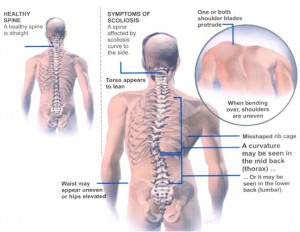- Scoliosis is the most common deformity of the spine.
- The condition causes the spine to abnormally curve sideways, into an “S” or “C” shape and to rotate.
- It may lead to chronic back pain, reduced respiratory function or diminished self-esteem
How common is it?
- One out of every 40 people, or about 7 million people in the U.S, have scoliosis.
- The condition can affect people of any age, but the most common age of onset is between 10 and 15 years of age.
- Each year, an estimated 30,000 children are fitted for braces and more than 100,000 children and adults diagnosed with scoliosis undergo surgery.
What are some of the signs and symptoms?
- Uneven shoulders, ribs, hips or waist,
- Noticeable sideways curve of the spine when viewed from the back.
- Appearance or texture of the ribs sticking up on one side as the child bends forward
How is it diagnosed?
- A doctor will take a medical history, perform a physical exam, order and review an x-ray and/or MRI and take measurements of the curve.
- A standard exam used in schools and by pediatricians is the Adam’s Forward Bend Test, in which the patient leans forward with feet together and the spine is evaluated
How is it treated?
- Most scoliosis patients have their spinal curvatures monitored by doctors, on a regular basis, to determine whether the curve is progressing.
- Special back bracing
- Surgery may be advised in severe cases
- Complementary methods like Egoscue for more active treatment of mild scoliosis. Egoscue is a form of POSTURE THERAPY where you are taught a large number of exercises that will improve posture and eliminate chronic pain. My friends at Pain Free Performance are local Egoscue Practitioners.
For more information about scoliosis see The Scoliosis Research Society

